
With its easy to use lessons, interesting and comprehensive videos, fun hands-on activities and myriad of extension resources to deepen learning, Mystery Science is not only an affordable and fairly comprehensive secular K-5 science curriculum, it’s one that students might actually love using.
What We Like
But watch out for…
What is Mystery Science?
Founded in 2011 and owned by Discovery Education, Mystery Science is a website that provides teachers and homeschooling parents with multimedia science lessons for their elementary school students.
To do so, Mystery Science teaches using a combination of entertaining topical videos, guided discussions, worksheets, hands-on activities and more.
The site offers specific plans for homeschooling families and offers topical mini-lessons in addition to their full, multi-week units.
What Ages or Grades is Mystery Science Intended For?
Mystery Science is intended for students in K-5 and meets NGSS standards in science education for those grades.
The company offers two types of lessons for these grades – mini-lessons, which are non-grade specific and can be done by students across K-5, and full units of lessons, which are linked to particular grades.
For homeschooling accounts, when it comes to Mystery Science’s full lessons, these units are divided across a number of age ranges, rather than a specific grade or age.
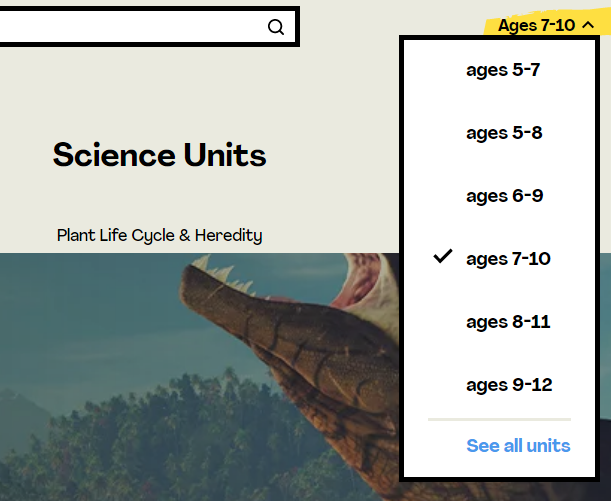
Parents can therefore freely select which age range their student falls into and get started with the units linked to those.
As might be expected of an elementary school science curriculum, every age range in Mystery Science offers units that cover the spectrum of life, physical and earth and planetary science.
That said, to give parents an idea of what might be on offer, we’ve created the table below with some of the units of study we saw in each grade when we accessed and began using the site.
Parents should note that Mystery Science does update and refresh its curriculum from time to time, changing its units of study and adding/modifying lessons pretty freely, so while these are correct at time of writing, they may change in the future.
| Grade | Example of Units |
| K | Plant Secrets, Animal Secrets, Wild Weather, Circle of Seasons, Sunny Skies, Force Olympics |
| 1 | Animal Superpowers, Plant Superpowers, Spinning Sky, Lights and Sounds |
| 2 | Animal Adventures, Plant Adventures, Work of Water, Material Magic |
| 3 | Animals Through Time, Power of Flowers, Stormy Skies, Invisible Forces, Circle of Life |
| 4 | The Human Machine, Birth of Rocks, Waves of Sound, Energizing Everything |
| 5 | Web of Life, Watery Planet, Spaceship Earth, Chemical Magic |
Parents are free to choose the order in which their students study any of these units and subjects, a bit of welcome flexibility that can help spark a student’s interest in science by allowing them to start learning with things that interest them (animals, space, volcanoes, physical motion etc).
Further, although the program’s units are linked to specific grades and ages, a subscription to Mystery Science includes access to all content on the site, meaning that parents can freely select units and lessons from age ranges above and below that of their student.
This can make the program quite useful for homeschooling families learning outside of a typical grade progression, such as families with precocious science learners and those whose students are behind in their science.
That said, each unit and lesson on the site makes pretty obvious references to the particular grade to which they are linked, which can make things a little more embarrassing for students working below grade level.
Further, parents should also be aware that the associated workload for each lesson tends to be grade-linked, as well.
So, for example, while a younger, precocious science learner may have an interest and knowledge in a subject that lets them learn from videos at a higher age/grade range, the written work, activities, optional readings and discussions may be a little over their head.
They may, for example, require a little more advanced critical thinking and reading comprehension skills to complete, which can frustrate younger students.
As a result, it’s best that parents of students wanting to work ahead of their grade or age look at the whole lesson, including its associated workload, before diving in.
How is Mystery Science Accessed?
Mystery Science is a web-based service, meaning that parents create an account and log in through a website to access the content.
On the plus side, this means that there are no apps to download, and parents can access the lessons wherever they are and from whatever device they happen to be using (as long as it has a browser).
As with other web-based programs, however, it does mean that homeschools will, by and large, have to have access to reliable and decent quality internet to use the program in real time.
Although it does require an internet connection to work, one thing we do like about Mystery Science is that the company has included the ability to “download” lessons into the device cache.

In other words, unlike most online learning programs out there, parents can click a button that will load the lesson into a new tab.
The lesson will then pre-load, allowing its videos to be played even if the internet goes down in the middle of a lesson.
This can be very helpful for homeschooling parents who live in areas where the internet is slow and/or spotty, as parents can load up a lesson ahead of time and work without interruption.
This can also be a good workaround for parents who simply don’t want to leave their student with an internet-connected device.
Such parents can pre-load videos, download and print any activities or worksheets and then switch their wifi off before beginning a lesson.
How It Works
Mystery Science is a subscription-based provider of science lessons that operates somewhat like a streaming service mixed with an online learning platform.
After subscribing to the program, parents create an account that gives them access to the site’s content.
Parents are asked to provide their student’s age, which then slots the account into one of several age ranges located at the top of the screen and displays the units relevant to that age or grade range.
An account with Mystery Science is all-access, however, and parents can freely switch age ranges and access the materials from other grades if they’d like, a bit of added flexibility that is always nice to have and that we feel can suit the often more diverse needs of homeschooling families.
Once inside a particular level, parents and students can pick freely from the units that are displayed, studying them in any order they’d like.

Each unit is made up of several lessons, and these build upon one another and so need to be done in order.
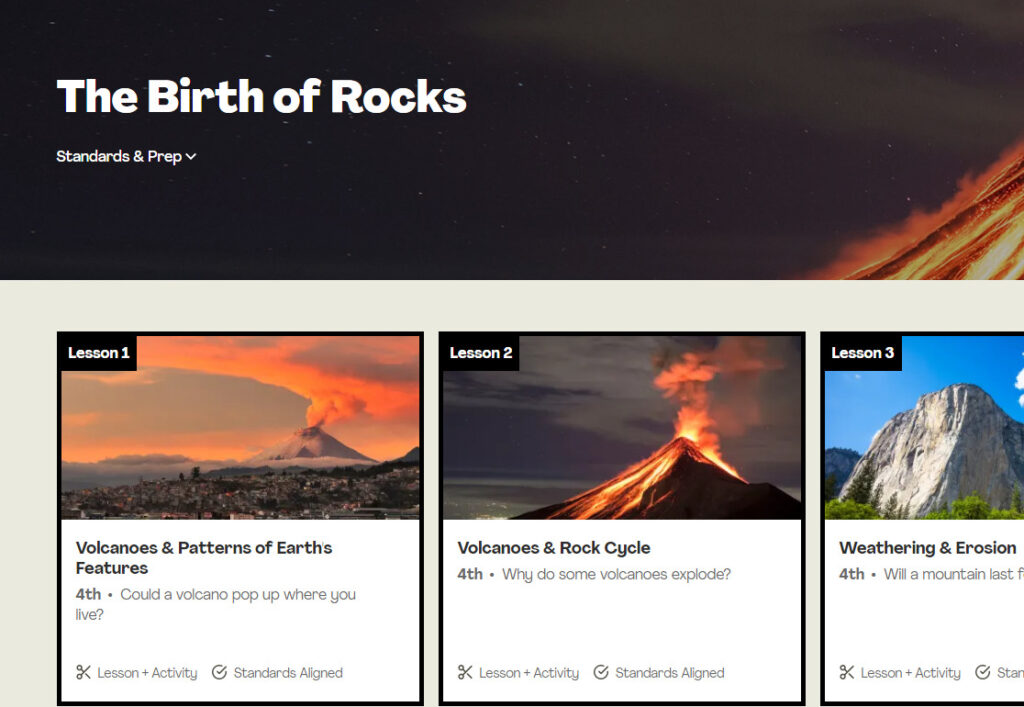
Lessons in Mystery Science follow a fairly consistent structure and are made up of three parts – a video-base exploration of a topic, a hands-on activity, a wrap-up and some optional lesson extensions.
Lesson Page
Once parents click on a lesson, they are brought to that lesson’s page.
This page is really something of a lesson plan and is laid out accordingly.

Parents are given a lot of helpful information about the lesson and what they’ll need to, such as an estimate of lesson length, an brief overview of the lesson and what it will accomplish, a materials list, an overview of the grade standards and “big idea” that’s being touched on and so on.
One thing we found helpful is that the materials list is actually something like a little app, rather than just a written list.
Mystery Science is originally designed for traditional classrooms where 30 or more students are learning at the same time, and by default (as with many similar science programs) the materials information reflects this in the quantity of items it lists.
Unlike other science programs, however, with Mystery Science parents can actually input the number of students they are teaching and the quantities will adjust automatically, saving them the need to do some quick math, which can be quite helpful and something of a timesaver.
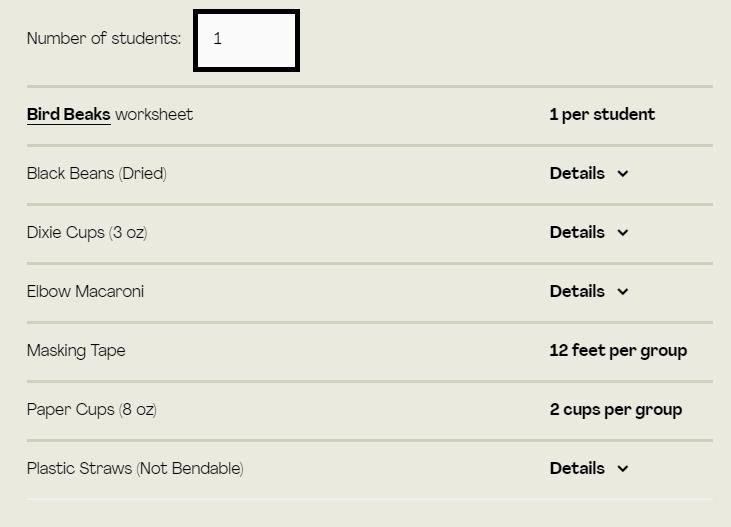
Exploration
Parents and students begin a lesson in Mystery Science with a video.
These videos use a combination of film, illustrations, stop motion and voice over to introduce and explain a particular concept in science.

A narrator generally details the scientific facts and concepts in question while movies or relevant pictures appear on screen with certain features sometimes being highlighted or pointed out, depending on what’s being learned.

The video lessons are fairly short, usually only 2-5 minutes long, but we feel they do a pretty good job at explaining things clearly and succinctly to students, often highlighting important vocabulary and ideas that students should know.
At times, the video lessons will pause to introduce a question/topic for discussion, which in homeschool settings will likely be between parent and child.

Once the discussion is complete, parents and students can click ahead and dive into another video that serves to explain and/or answer the discussion question in some depth.
Activity
Mystery Science incorporates a hands-on science activity into each of its lessons, and each lesson’s video will pause at certain times to introduce it.
These activities are a mixture of demonstrations and experiments that are designed to demonstrate the lesson’s scientific concepts in a more intuitive and engaging way.
Students might, for example, build a telephone out of styrofoam cups and string, make bird beaks out of kitchen materials, or even build a paper model of a mountain to explore the path of water and rainfall in the wild.
Overall, the activities in Mystery Science can be a lot of fun, dynamic and engaging for both parents and students to work through.
They are based on common household materials, so don’t really require any special kits or equipment, although since each lesson contains an activity, parents may need to do a little shopping from time to time.
(The company does sell pre-packaged supplies as “Mystery Packs,” but these are aimed at traditional schools and contain supplies for around 30 children – a bit overkill for most homeschools).
One thing we liked is the fact that the activities and demonstrations in Mystery Science are designed to work with the lesson videos, rather than being a separate or supplementary activity.
As we’ve mentioned, the videos serve to introduce the hands-on activity for the lesson, but also spend time linking what the student is doing to the lesson material itself, making these activities far more of an intuitively relevant educational exercise, rather than just something fun to do.
More than that, the videos actually provide step by step instructions for setting up and running these demonstrations and experiments and actually provide video demonstrations for each step.

As a result, things are far less likely to go disastrously wrong for students and parents when it comes to Mystery Science’s activities, so they can focus more on the effects and results of what they’re doing rather than setup and troubleshooting.
All this can, of course, be very helpful for parents who are new to homeschooling and those whose home science skills have become a bit rusty over time.
Wrap Up
Following the hands-on activity component of a lesson, Mystery Science usually includes a wrap up section of their video.
These usually offer some questions for students to discuss with their parents, generally encouraging them to take what they’ve learned to the next logical level.

The program then answers at least some of these questions, introducing concepts for further learning, and often incorporating what they’ve learned from their activity, as well.
Extensions
Following the lesson video and its activity, parents have the option of deepening student learning with a few more activities and exercises.
What a lesson might offer depends on the grade level and subject, but there are some common elements that we describe below.
Videos
From time to time, parents and students will have access to additional educational videos that can be useful in continuing the learning in a little more depth.
They might have a particular way of demonstrating a concept, show how scientists have conducted experiments to test a concept or simply approach a concept in a slightly different way.
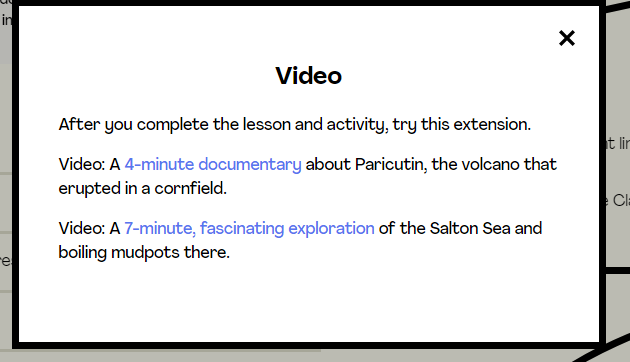
They may also offer more questions and topics for discussion.
Some of these videos are hosted on Mystery Science, while others are hosted on 3rd party websites, such as Youtube, PBS Learning Media and more.
For example, in a lesson about animal eye structure and function, students might be given the following extension video prompt.
When clicking the link, they will be redirected to a page with a youtube video that shows how gecko eyes work.
Reading
Mystery Science usually offers students and parents some readings or books that they can take a look at in order to examine a scientific concept in more detail.
At the younger levels, these can be living books and selections from various science readers, which introduce science concepts in a more approachable and engaging way, usually being written in a more casual and friendly style and often having some illustrations to make things more entertaining.
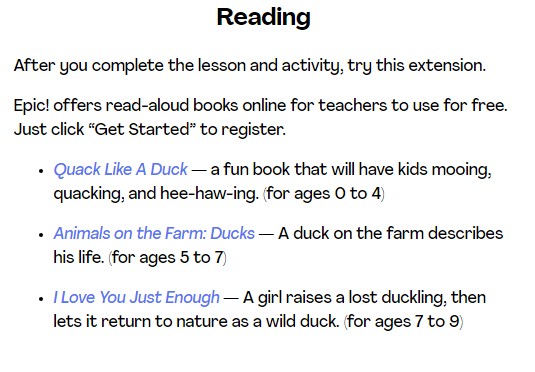
Students ages 5-8 learning about offspring traits, for example, might read (or have read to them) Meet My Family: Animal Babies and Their Families, a picture book discussing animal child-rearing habits.
Older students, meanwhile, may be offered an assortment of topical articles and short readings about certains topics or discoveries in science.
These extra readings can introduce more of a literature-based component to the program that many homeschools will really appreciate.
It can also help students practice their reading and comprehension skills as they learn science, which is always nice.
One thing to keep in mind, however, is that while some articles are hosted on Mystery Science, many are located on 3rd party websites (such as Epic!, ReadWorks and some others) that parents will have to register or sign up to use as they lie behind a paywall.

Assessments
To help formalize the learning a bit, Mystery Science also offers parents the ability to issue quizzes and tests.
The format of these tests can depend a good deal on the age of the student they are aimed at.
At the younger levels, these are similar to workbook exercises, while at the older levels they tend to include things like short answer questions, multiple choice and fill in the blanks.
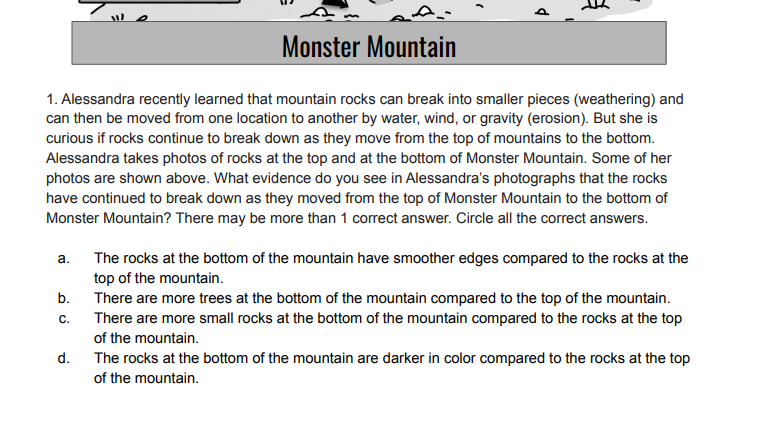
By and large, the assessments in Mystery Science are pretty short and aren’t too demanding, in our opinion, and so shouldn’t inspire too much terror in the hearts of even test-phobic students.
They also tend to come in lesson and unit test formats, so parents have the option of changing up the frequency of assessment (if they choose to administer any), depending on their students’ needs, which is quite useful.
Extra Activities
In addition to the main activity of a lesson, Mystery Science lessons may also have some ideas for further hands-on activities that parents and students can try out if they want to dig deeper into a particular idea.
Like the main hands-on activity, these tend to be based on household goods, so there might be experiments such as using glue to make fossil casts at home, watching the evaporation of liquid in two different cups, and so on.

Some of these activities are internal to the site and will pop up when clicked.
Others, however, are hosted on a variety of 3rd party educational websites, such as the Smithsonian, the Kentucky Geological Survey and so on, so parents may need to click away from the Mystery Science website from time to time.
Discussion Ideas and Questions
Mystery Science also offers parents and students some more ideas and questions that they can use to spark discussions and deeper thinking about a topic, as well as some research resources to help have a more meaningful and thoughtful discussion.
While perhaps not for everyone, these extra discussions can be a fun component for homeschools that enjoy a lot of back and forth exploration.
They also allow students more of an opportunity to offer their opinions and thoughts, which can increase their personal engagement with the learning material, which can ultimately better help them remember what they’re learning.
Transcripts
One thing we liked is that Mystery Science offers ready transcripts for its video lessons.

These can be used as a more thorough concept review before a test, but perhaps more importantly they increase the accessibility of the program, making it easier for students with processing or hearing difficulties to learn.
Mystery Science Mini Lessons
In addition to the main lessons described above, Mystery Science also offers what it calls Mini-Lessons.
These are 5 minute videos that are hosted by Doug Peltz, co-founder of Mystery Science, as well as a variety of other lecturers.
These Mini-Lessons touch on a variety of more casual, but interesting, science-related topics, such as where chocolate comes from, whether bats drink blood, why the sky is blue and so on.
As opposed to the more formal lectures of the full Mystery Science lessons, these videos focus more on questions that students might themselves ask or are curious about.
They are also more high energy, with hosts appearing on-screen with animations and other props to help explain concepts in a more engaging way.
While certainly entertaining, these mini-lessons are a bit less formal, structured and thorough as compared to the main lessons, but can be a good way to engage reluctant students by diving into topics they may actually be curious about in a more entertaining and dynamic manner.
Our Thoughts On Mystery Science Lessons
Overall, we feel that Mystery Science can be a very straightforward and convenient online platform for homeschooling families.
We found that it teaches its science pretty thoroughly, touching on a wide-range of concepts through strong multimedia explanations, thought-provoking discussion prompts and interesting hands-on science activities and exercises.
These are further enhanced by a host of optional readings, assessments, activities, third party resources and more, that parents can use to further enrich and deepen learning.
Yet, while the science itself is kept at a decently high level, we feel the program makes sure that it is discussed in as approachable a manner as possible, using a more casual tone and lots of video, animations, activities and illustrations to help students better understand what they’re learning about.
The lessons are also kept fairly short, typically 30-40 minutes at the younger grades and extending to about an hour or so at the upper levels.
This shorter length, combined with the use of multimedia learning and hands-on activity, means that lessons shouldn’t feel too intimidating and boring to go through for students.
In addition, we liked the fact that Mystery Science lessons are very easy to use and pretty much open and go.
The videos really guide students through the whole process of learning, from instruction to discussion to the lesson’s main activity and, finally, to its conclusion.
And it does so in a very step-by-step and careful manner.
The video will pause at the correct moments, introduce a lesson component, and then move only once parents and students are ready to do so and click on the appropriate arrow.
We especially like the fact that the videos carry both students and parents step by step through the process of setting up, carrying out and interpreting the science-based lesson activity, often making use of videos, pictures, written text, voice over and illustrations to get their instructions across.
In contrast to other programs, which make use of written lab or teacher’s manuals to do so, Mystery Science’s video-based, sequential approach to its hands-on activities means that there is very little that can go wrong in setting up and carrying out an experiment.
With fewer mistakes to be made, not only do lessons tend to go more smoothly, but students may end up feeling a bit more confident about their ability to do science.
Furthermore, we liked the fact that Mystery Science is a very flexible program on the whole, and feel that this is something that homeschools will really appreciate.
Parents and students can, for example, choose what grade level they would like to work at, which topics and units in science they would like to study, and they even have a free hand in choosing how deep to take the learning, with a wide variety of lesson enrichments and exercises that can be added onto the core lesson (videos, assessments, additional activities, etc.).
Finally, we enjoyed the fact that Mystery Science’s teaching style is very student centric.
Unlike some other digital science programs, such as Generation Genius for example, Mystery Science frequently stops to ask students to offer their thoughts, opinions and ideas about what they are learning.
Whether it is through its discussions or through its periodic exercises or enrichments, there is a lot of room in this program for students to express themselves, which can increase their overall engagement and interest in both the lessons and science in general.
On the downside, although the videos are informative and very effective, we didn’t feel that they were the most exciting out there.
For the most part, when it comes to Mystery Science’s full lessons at least, the videos are a mixture of voice over and imagery (videos, illustrations) and there isn’t much of the way of live acting, props, fun animations or other dynamic elements.
As a result, they can be a little less thrilling to students to look at than some of its competitors, such as Supercharged Science or Generation Genius.
Another issue that some homeschools may have with Mystery Science is the fact that, although it is an online learning platform, it doesn’t offer any progress tracking or grading tools for parents to use.
The overall idea is that it can integrate with a teacher’s personal rubric, but this ultimately means that parents will have to figure out their own way to keep track of assignments, grades, pace and so on.
Finally, and this is less of a drawback and more of something that parents should be aware of, is the fact that, despite appearances, Mystery Science is not a self-study program.
Although students do have the opportunity to do some of the work and activities on their own, parents will likely be quite involved in lessons as facilitators, guides and as participants in discussions.
Further, parents will also need to help make decisions regarding the overall learning pathway (which units to study and in what order), figure out which learning extensions to add, administer and prepare assignments, grade student work, oversee activities and so on.
As a result, there is a fair amount of parental time and effort required with this program, which can be something that can be an issue for really busy homeschools.
Is Mystery Science A Complete Curriculum?
With its videos, projects and access to online resources, Mystery Science can be used as a complete curriculum on its own, as a spine or as a supplement to another homeschool science program.
At the K-2 level, in particular, we feel its mixture of multimedia lectures, discussions and hands-on demonstrations should be more than enough for most students.
With older students (grades 3-5), however, using only the main core of the program’s lessons (video instruction, activities, summary) might be a little thin for most students.
We would recommend, then, that parents make use of the extension resources, particularly the readings and assessments, for each unit to really maximize the depth and formality of learning.
Combined with these extensions, we feel that Mystery Science can be a very solid science curriculum for most elementary school students.
Is Mystery Science A Secular Curriculum?
Yes, Mystery Science is a completely secular elementary school science curriculum.
The program makes no reference to any religious content whatsoever, and touches on concepts such as heredity, natural selection, the geological age of the earth, the fossil record and so on.
As a result, it can be a good option for those looking for a secular homeschool science curriculum.
It may not, however, be ideal for faith-based or neutral homeschools.
Is The Program Easy to Teach?
Mystery Science is actually pretty straightforward and easy to use, in our opinion.
The program’s video lectures do an excellent job at guiding parents and students through the learning, discussion, activity and wrap up components, and do so in a very step by step and easy to follow way.
As a result, there’s very little chance of parents and/or students getting lost and parents don’t really need a lot of teaching experience or science background to use these lessons, something that should appeal to homeschooling parents who are unsure about their own skills and knowledge.
Further, beyond buying and preparing supplies for the assorted activities, there is very little prep that parents will have to do, making the program quite open and go.
Pros and Cons of Mystery Science
Pros
Highly affordable
Mystery Science is offered to both school districts and homeschools.
For homeschooling families, the program costs around $99 per year and includes access to all the website’s content (videos, activities, assessments and most readings), making it a very cost effective and expansive science program.
Lessons are very engaging
Mystery Science’s video lessons cover a wide variety of science topics and are filled with bright and colorful videos, pictures and animations, and are narrated pretty well, with thought provoking questions and discussions introduced periodically.
As a result, we feel they do a good job at keeping students watching and engaged with the material presented.
Activities are a lot of fun and hands-on
Every lesson in Mystery Science contains one (or more) hands-on learning activity to help students better understand the scientific concepts presented.
Whether they are building models of mountains, conducting experiments with magnets, making foil mittens, or building bridges out of paper, students will have a lot of fun during their lessons and generally have a lot of opportunity to get their hands dirty actually doing science, rather than just reading about it.
Easy to Use, Open and Go
With lessons and website materials that both explain scientific concepts and lead students and parents through discussions and activities, there really isn’t a whole lot of prep-work needed to teach Mystery Science.
Aside from having to gather and organize activity materials, parents can essentially log in, click on a lesson and start learning.
Strong science teaching
Although it explains science concepts in an approachable and straightforward way, with lots of hands-on learning, Mystery Science still takes its science seriously.
Lessons are NGSS standards-aligned and introduce all the relevant scientific concepts and vocabulary that one might expect from a science program, and even includes a good number of optional resources (tests, extra videos, discussion ideas, scientific readings) that can help strengthen the learning even further.
Accessible
Mystery Science videos and learning materials are available in English and Spanish and videos are closed captioned and transcribed, making the program a lot easier for ESL learners, as well as those with hearing and processing difficulties.
Very flexible
Parents have a lot of choice for learning when it comes to Mystery Science.
Parents can choose which grades they would like to learn from, which subjects and units they would like to start with and can choose to deepen the learning as much as they’d like with the many optional lesson extensions that are available.
Learning is student-centric
Unlike many other science programs that tend to involve a lot of top-down lecturing, Mystery Science often stops to ask students for their thoughts, ideas, and opinions about what they are learning, whether this is in specific exercises, casual in-lesson questions or longer and more formal discussions.
As a result, the curriculum can be said to be a little more centered around the student than others, which can make it more personal, interesting and engaging for them.
Fun, low-pressure mini-lessons
Aside from the main lessons, Mystery Science also offers Mini-Lessons on a wide variety of science-linked topics that can be a lot more fun, easy and pressure-free for students to work on, which can in turn spark an interest in science with more reluctant students.
Cons
Full lesson videos aren’t the most dynamic we’ve ever seen
By and large, the videos in Mystery Science involve narration over videos, pictures and illustrations and aren’t really as high-energy and dynamic as some other videos we’ve seen teach science, which may use props, live hosting, animations and so on.
No progress tracking functions
Although it does provide full lessons, worksheets and assessments in science, Mystery Science doesn’t really have any in-built progress tracking or grading functions that parents can use to make administering its courses a little easier.
May require parents to sign up to websites to access resources at times
One thing we really liked about Mystery Science is the potential for integrating readings and living books into the lessons.
Unfortunately, many of these are hosted on other stites that, at a minimum, may require parents to create an account.
Who Is it Ideal For?
Homeschooling families in areas with spotty or slow internet service
Mystery Science is rather unusual as an online curriculum provider as it allows users to pre-load or “download” its lesson material into a browser tab ahead of time, meaning they can then study even if the internet goes out.
As a result, it can provide a better digital learning experience for those who live in areas where the internet is slow or inconsistent.
Parents looking for a fun and interactive K-5 science curriculum
Mystery Science teaches its science through a combination of multimedia lessons, fun hands-on activities and thought-provoking discussions, all of which can be a lot more fun and engaging compared to a standard science lecture or textbook.
Parents looking for a comprehensive science curriculum
Mystery Science is NGSS standards-aligned and teaches all the science concepts that students are expected to understand from its units, including the relevant vocabulary.
There are also a great number of extra learning opportunities for each lesson that students can access to deepen their learning, including scientific readings, additional science videos, additional activities and broad discussions.
Students who enjoy hands-on learning
Mystery Science contains at least one hands-on learning activity per lesson (and often an option for more in the lesson extension), connecting students to concepts and ideas with the help of physical experiments and demonstrations.
It can therefore be an interesting option for tactile learners.
Students who do well with audio-visual learning
Mystery Science teaches using videos, voice overs, animations and illustrations, exploring topics in an in-depth, comprehensive and dynamic way.
It can therefore be a good option for those who learn best through multimedia learning.
Fans of discussion-based learning
Some parents really enjoy discussing things with their children, enjoying the opportunity to teach, bond over the learning and get insight into their child’s thinking process.
Each lesson in Mystery Science includes a discussion between parents and students on certain topics and it can therefore be a great option for these parents.
Homeschools on a budget
Costing less than $100 per year for homeschoolers and providing access to a complete set of K-5 digital learning materials and content, Mystery Science can be a very cost-effective and budget friendly way to teach science at home.
Who Is It Not Ideal For?
Stricter, faith-based homeschools
Mystery Science is a secular K-5 science curriculum and touches upon some subjects that might be unsuitable for stricter faith-based homeschools, such as evolution, the fossil record and the geologic age of the Earth.
Those looking for a self-study science curriculum
Although it does make teaching science a lot easier, Mystery Science still requires a good deal of parental interaction, guidance and administration throughout its lessons, and really isn’t a self-study program.
Price
Note: All prices are correct as of writing. All prices in USD.
When it comes to homeschooling families, Mystery Science has a pretty simple price structure.
The program costs $99 per year per household and includes access to all the materials on the website.
As always, we recommend parents check for the latest prices and any discounts or sales that might be on offer.
Is It Worth the Price
Overall, we feel that Mystery Science can provide a lot of value to those looking for an online secular homeschool science curriculum.
A subscription to the program provides parents with an assortment of NGSS standards-aligned science units to study, each of which contains engaging video-based lessons, discussions and hands-on activities that make learning much more interesting and thought-provoking than a typical homeschool science textbook.
Lessons are further bolstered by an assortment of enrichment or extension resources, such as videos, activities, readings, discussions and more.
These resources frequently connect students to respected scientific institutions and websites, and can really help strengthen and deepen a student’s learning.
Further, each lesson’s video carefully guides both parent and student through all aspects of a lesson, from its teaching component to its activity and a discussion of results, all of which make using Mystery Science very easy and prep-free.
Finally, parents are given a great deal of flexibility with this program and can easily tailor it to their homeschool needs.
Parents can, for example, choose which grades to study, which science subjects and topics to begin with, and whether or not they would like to integrate additional resources and formal assessments into the learning.
Bottom Line
With its easy to use lessons, interesting and comprehensive videos, fun hands-on activities and myriad of extension resources to deepen learning, Mystery Science is not only an affordable and fairly comprehensive secular K-5 science curriculum, it’s one that students might actually love using.

About the Author
David Belenky is a freelance writer, former science and math tutor and a tech enthusiast. When he’s not writing about educational tech, he likes to chill out with his family and dog at home.
